Tagalog grammar
Tagalog grammar is the body of rules that describe the structure of expressions in the Tagalog language, the language of the Tagalog region of the Philippines.
In Tagalog, there are eight basic parts of speech: verbs, nouns, adjectives, adverbs, prepositions, pronouns, conjunctions and particles. Tagalog is a slightly inflected language. Pronouns are inflected for number; and verbs, for focus, aspect and voice.
Verbs
Tagalog verbs are morphologically complex and are conjugated by taking on a variety of affixes reflecting focus/trigger, aspect, voice, and others. Below is a chart of the main verbal affixes, which consist of a variety of prefixes, suffixes, infixes, and circumfixes.
Conventions used in the chart:
- CV~ stands for the reduplicated first syllable of a root word, which is usually the first consonant and the first vowel of the word.
- N stands for a nasal consonant which assimilates to ng, n, or m depending on the consonant following it. ∅ means that the verb root is used, therefore no affixes are added.
- Punctuation marks indicate the type of affix a particular bound morpheme is; hyphens mark prefixes and suffixes, and ⟨um⟩ is an infix that is placed between the first consonant and the first vowel of a root word. The word sumulat (s⟨um⟩ulat) (actor focus and completed aspect or infinitive) is composed of the root word sulat and the infix ⟨um⟩. Its other conjugated forms are susulat (su~sulat) and sumusulat (s⟨um⟩u~sulat).
With object-focus verbs in the completed and progressive aspects, the infix -in- frequently becomes the infix -ni- or the prefix ni- if the root word begins with /l/, /r/, /w/, or /y/; e.g., linalapitan or nilalapitan and inilagay or ilinagay.
With the suffixes -in and -an, if the root word ends in a vowel, the suffixes insert an h at the beginning to become -hin and -han to make speaking more natural. This does not usually happen with root words ending in pseudo-vowels such as w and y. An example of this is basa which becomes basahin rather than basain.
The imperative affixes are not often used in Manila, but they do exist in other Tagalog speaking provinces.
| Complete | Progressive | Contemplative | Infinitive | Imperative | |
|---|---|---|---|---|---|
| Actor trigger I | ⟨um⟩
bumasa |
C⟨um⟩V~
bumabasa |
CV~
babasa |
⟨um⟩
bumasa |
∅ |
| Actor trigger II | nag-
nagbasa |
nag-CV~
nagbabasa |
mag-CV~
magbabasa |
mag-
magbasa |
pag-
pagbasa |
| Actor trigger III | na-
nabasa |
na-CV~
nababasa |
ma-CV~
mababasa |
ma-
mabasa |
∅ |
| Actor trigger IV | nang-
nangbasa |
nang-CV~
nangbabasa |
mang-CV~
mangbabasa |
mang-
mangbasa |
pang-
pangbasa |
| Object trigger I | ⟨in⟩
binasa |
C⟨in⟩V~
binabasa |
CV~ ... -(h)in
babasahin |
-in
basahin |
-a (or verb root)
basa |
| Object trigger II | i⟨in⟩-
ibinasa |
i-C⟨in⟩V~
ibinabasa |
i-CV~
ibabasa |
i-
ibasa |
-an (or -i)
basaan |
| Object trigger III | ⟨in⟩ ... -(h)an
binasahan |
C⟨in⟩V~ ... -(h)an
binabasahan |
CV~ ... -(h)an
babasahan |
-(h)an
basahan |
-i
basai |
| Locative trigger | ⟨in⟩ ... -(h)an
binasahan |
C⟨in⟩V~ ... -(h)an
binabasahan |
CV~ ... -(h)an
babasahan |
-(h)an
basahan |
∅ |
| Benefactive trigger | i⟨in⟩-
ibinasa |
i-C⟨in⟩V~
ibinabasa |
i-CV~
ibabasa |
i-
ibasa |
∅ |
| Instrument trigger | ip⟨in⟩aN-
ipinabasa |
ip⟨in⟩aN-CV~
ipinababasa |
ipaN-CV~
ipababasa |
ipaN-
ipabasa |
∅ |
| Reason trigger | ik⟨in⟩a-
ikinabasa |
ik⟨in⟩a-CV~
ikinababasa |
ika-CV~
ikababasa |
ika-
ikabasa |
∅ |
Aspect
The aspect of the verb indicates the progressiveness of the verb. It specifies whether the action happened, is happening or will happen. Tagalog verbs are conjugated for time using aspect rather than tense.[1][2]
The complete aspect of a verb indicates the action has been completed. The progressive aspect of a verb indicates the action has been started but not been completed or that the action is habitual or a universal fact. The contemplative aspect of a verb indicates that the action has not happened but is anticipated. Some verbs take a fourth aspect known as the recently complete aspect which indicates that the action has just been completed before the time of speaking or before a specified time.[3]
| Complete | Progressive | Contemplative | Recently Complete | |
|---|---|---|---|---|
| Tagalog | Nagluto ang babae | Nagluluto ang babae | Magluluto ang babae | Kakaluto lang ng babae |
| English translation | The woman cooked
The woman has cooked |
The woman cooks
The woman is cooking |
The woman will cook
The woman is going to cook |
The woman has just cooked |
Trigger
The central feature of verbs in Tagalog and other Philippine languages is the trigger system, often called voice or focus.[4] In this system, the thematic role (agent, patient, or oblique) of the noun marked by the direct-case particle is encoded in the verb.
In its default unmarked form, the verb triggers a reading of the direct noun as the patient of the clause. In its second most common form it triggers the noun as the agent of the clause. Other triggers are location, beneficiary, instrument, reason, direction, and the reciprocal.
There are three main patient-trigger affixes:
- -in is used for:
- Items that are moved towards the actor: kainin (to eat something), bilhín (to buy something).
- Items that are permanently changed: basagin (to crack something), patayín (to kill something).
- Items that are thought of: isipin (to think of something), alalahanin (to remember something).
- i- is used for items which undergo a change of state such as being moved away from an actor: ibigáy (to give something), ilagáy (to put something), itaním (to plant something).
- -an is used for items undergoing a surface change (e.g., cleaning): hugasan (to rinse something), walisán (to sweep something off).
Affixes can also be used in nouns or adjectives: baligtaran (from baligtád, to reverse) (reversible), katamaran (from tamád, lazy) (laziness), kasabihán (from sabi, to say) (proverb), kasagutan (from sagót, answer), bayarín (from bayad, to pay) (payment), bukirín (from bukid, farm), lupaín (from lupa, land), pagkakaroón (from doón/roón, there) (having/appearance), and pagdárasál (from dasál, prayer). Verbs with affixes (mostly suffixes) are also used as nouns, which are differentiated by stress position. Examples are panoorin (to watch or view) and panoorín (materials to be watched or viewed), hangarín (to wish) and hangarin (goal/objective), aralin (to study) and aralín (studies), and bayaran (to pay) and bayarán (someone or something for hire).
The agent-trigger affixes are -um-, mag-, man-, and ma-. The difference between mag- and -um- is a source of confusion among learners of the language. Generally speaking there are two main distinctions among many; mag- refers to externally directed actions and -um- for internally directed actions. For example, bumilí means to buy while magbilí means to sell. However this isn't writ law for these affixes; there are exceptions for example, mag-ahit means to shave oneself while umahit means to shave someone. magbili and umahit are rarely used; in southern dialects of Tagalog na- is used instead of -um-.
ma- is used with only a few roots which are semantically intransitive, for example, matulog (to sleep). ma- is not to be confused with ma-, the potentiative prefix for patient-triggered verb forms.
- Bumilí ng saging ang lalaki sa tindahan para sa unggóy.
- The man bought bananas at the store for the monkey.
Compared with:
- Binilí ng lalaki ang saging sa tindahan para sa unggóy.
- The man bought the banana at the store for the monkey.
The locative trigger refers to the location or direction of an action or the area affected by the action.
- Binilhan ng lalaki ng saging ang tindahan.
- The man bought bananas at the store.
The benefactive trigger refers to the person or thing that benefits from the action; i.e., the beneficiary of an action.
- Ibinilí ng lalaki ng saging ang unggóy.
- The man bought bananas for the monkey.
Compared with:
- Binilihan ng lalaki ng saging ang tindahan.
- The man bought bananas for the store.
The instrumental trigger refers to the means by which an action is performed.
- Ipinambilí ng lalaki ng saging ang pera ng asawa niyá.
- The man bought bananas with his wife's money.
The reason trigger refers to the cause or reason why an action is performed.
Ikinagulat ng lalaki ang pagdatíng ng unggóy.
"The man got surprised because of the monkey's arrival."
The directional trigger refers to the direction the action will go to.
- Pinuntahan ng lalaki ang tindahan.
- The man went to the store.
The reciprocal trigger refers to the action being done by the subjects at the same time. The subject is usually compound, plural or collective.
- Naghalikan ang magkasintahan.
The couple kissed (each other).
Mood
Tagalog verbs also have affixes expressing grammatical mood; Some examples are indicative, causative, potential, social, and distributed.
Indicative
Nagdalá siyá ng liham.
"He brought a letter."
Bumilí kamí ng bigás sa palengke.
"We bought rice at the market."
Kumain akó.
"I ate."
Hindî siyá nagsásalitâ ng Tagalog.
"He/She does not speak Tagalog."
Causative pa-
Nagpadalá siya ng liham sa kaniyáng iná.
"He sent (literally: caused to be brought) a letter to his mother."
Distributive
Namili kamí sa palengke.
"We went shopping at the market."
Social
Nakikain akó sa mga kaibigan ko.
"I ate with my friends."
Potential naka-
Hindî siyá nakapagsásalitâ ng Tagalog.
"He is not able to speak Tagalog."
Focus
Tagalog verbs also inflect based on focus. A verb can be in either the actor focus or the object focus. Such inflections are typically irregular and must be memorized with each verb learned. However, in general, -um- verbs are in the actor focus while -in- verbs are in object focus.
In the actor focus, the agent is introduced by ang, or si for names, and the object is introduced by ng, equivalent to English the and a/an respectively. The object cannot be a specific given name or surname of a person or animal. This focus is also used for intransitive verbs.
Gumalaw si Joe.
"Joe moved."
Nagbasa ako ng libro.
"I read (past tense) a book."
In the object focus, meanwhile, the agent is introduced by ng, or ni for names, and the object is introduced by ang, or si for names. If a sentence has an object focus verb but no indicated object, then this means that the object is inferred and is already known.
Ginalaw ni Joe.
"Joe moved [it]."
Binasa ko ang libro.
"I read the book."
There are also different forms of pronouns for each focus.
Nouns
While Tagalog nouns are not inflected, they are usually preceded by case-marking particles. These follow an Austronesian alignment, also known as a trigger system, which is a distinct feature of Philippine languages. There are three basic cases: direct (or absolutive, often inaccurately labeled the nominative); indirect (which may function as an ergative, accusative, or genitive); and oblique.
The direct case is used for intransitive clauses. In transitive clauses using the default grammatical voice of Tagalog, the direct marks the patient (direct object) and the indirect marks the agent, corresponding to the subject in English. In the more marked voice the reverse occurs, with the direct marking the agent and the indirect marking the patient. Because the base form of the clause is superficially similar to the passive voice in English, this has led to a misconception that Tagalog is spoken primarily in the passive voice. It is also superficially similar to ergative languages such as those of Australia, so Tagalog has also been analyzed as an ergative language. However, the English passive clause is intransitive, and likewise in ergative languages one of the voices forms an intransitive clause, whereas in Tagalog both voices are transitive, and so align well with neither nominative–accusative languages such as English nor with ergative languages.
One of the functions of voice in Tagalog is to code definiteness, analogous to the use of definite and indefinite articles in English. When the patient is marked with the direct case particle, it is generally definite, whereas when it is marked with the indirect case it is generally indefinite.
The oblique particle and the locative derived from it are similar to prepositions in English, marking things such as location and direction.
The case particles fall into two classes: one used with names of people (proper) and one for everything else (common).
The common ergative marker is spelled ng and pronounced [naŋ]. Mgá, pronounced [maˈŋa], marks the common plural.
Cases
| Direct (ang) | Indirect (ng) | Oblique (sa) | |
|---|---|---|---|
| Common singular | ang, 'yung (iyong) | ng, n'ung (niyong) | sa |
| Common plural | ang mgá, 'yung mgá (iyong mgá) | ng mgá, n'ung mgá (niyong mgá) | sa mgá |
| Personal singular | si | ni | kay |
| Personal plural | sina | nina | kina |
Common noun affixes
| ka- | indicating a companion or colleague |
| ka- -an | collective or abstract noun |
| pan- | denoting instrumental use of the noun |
Examples
| Dumatíng | ang | lalaki. |
| (has) arrived | the | man |
"The man arrived."
| Nakita | ni Juan | si María. |
| saw | by (the) Juan | (the) María |
"Juan saw María."
Note that in the Philippine languages, even proper nouns require a case marker.
| Pupunta | siná | Elena | at | Roberto | sa | bahay | ni | Miguel. |
| will go | plural nominal article | Elena | and | Roberto | at | house | of | Miguel |
"Elena and Roberto will go to Miguel's house."
| Nasaan | ang mga | libró? |
| Where | the (plural) | book |
"Where are the books?"
| Na kay | Tatay | ang | susì. |
| Is with | Father | the | key |
"Father has the key."
| Malusóg | iyóng | sanggól. |
| Healthy | that | baby |
"That baby is healthy."
Pronouns
Like nouns, personal pronouns are categorized by case. As above, the indirect forms also function as the genitive.
| Direct (ang) | Indirect (ng) | Oblique (sa) | |
|---|---|---|---|
| 1st person singular | ako | ko | akin |
| 1st person dual | kitá/kata[5] | nita/nata[5] | kanitá/kanata (ata)[5] |
| 1st person plural inclusive | tayo | natin | atin |
| 1st person plural exclusive | kamí | namin | amin |
| 2nd person singular | ikáw (ka) | mo | iyó |
| 2nd person plural | kayó | ninyó | inyó |
| 3rd person singular | siyá | niyá | kaniyá |
| 3rd person plural | silá | nilá | kanilá |
| Direct second person (ang) with Indirect (ng) first person | |
|---|---|
| (to) you by/from me | kitá[6] |
Examples:
Sumulat ako.
"I wrote."
Sinulatan ako ng liham.
"He/She wrote me a letter."
Note: If "ng liham" is removed from the sentence, it becomes "I was written on"
Ibíbigay ko sa kaniyá.
"I will give it to him/her."
Genitive pronouns follow the word they modify. Oblique pronouns can take the place of the genitive pronoun but they precede the word they modify.
Ang bahay ko.
Ang aking bahay.
"My house."
The inclusive dual pronoun kata/kitá has largely disappeared from the Manila Dialect. It survives in other Tagalog dialects, particularly those spoken in the rural areas. However kitá is used to replace the pronoun sequence [verb] ko ikaw, (I [verb] you).
The 1st-2nd dual pronoun "kata/kitá" referring to "you and I" is traditionally used as follows:
Mágkaibigan kitá. (Manila Dialect: Mágkaibigan tayo.)
"You and I are friends." (Manila Dialect: “We are friends.")
As previously mentioned, the pronoun sequence [verb] ko ikáw, (I [verb] you) may be replaced by kitá.
Mahál kitá.
"I love you."
Bíbigyan kitá ng pera.
"I will give you money."
Nakita kitá sa tindahan kahapon.
"I saw you at the store yesterday."
Kaibigan kitá.
"You are my friend."
The inclusive pronoun tayo refers to the first and second persons. It may also refer to a third person(s).
The exclusive pronoun kamí refers to the first and third persons but excludes the second.
Walâ tayong bigás.
"We (you and me) have no rice."
Walâ kaming bigás.
"We (someone else and me, but not you) have no rice."
The second person singular has two forms. Ikáw is the non-enclitic form while ka is the enclitic which never begins a sentence. The plural form kayó is also used politely in the singular, similar to French vous.
Nouns are gender neutral, hence siyá means both he or she.
Polite or formal usage
Tagalog, like many languages, marks the T–V distinction: when addressing a single person in polite/formal/respectful settings, pronouns from either the 2nd person plural or the 3rd person plural group are used instead of the singular 2nd person pronoun. They can be used with, or in lieu of, the pô/hô iterations without losing any degree of politeness, formality or respect:
- ikáw or ka ("you" sgl.) becomes kayó ("you" pl.) or silá ("they")
- mo (post-substantive "your") becomes niyó or ninyó (more polite), (post-substantive "your" pl.) or nilá (post-substantive "their")
- iyó(ng) ("yours" sgl. or pre-substantive "your" sgl.) becomes inyó(ng) ("yours" pl. or pre-substantive "your" pl.) or kanilá(ng) ("theirs" or pre-substantive "their")
Example:
English: "What's your name?"
Casual: Anó'ng pangalan mo?
Respectful: Anó'ng pangalan ninyo? or Anó'ng pangalan nilá?
Using such pluralized pronouns is quite sufficient for expressing politeness, formality or respect, particularly when an affirmative (or negative) pô/hô iteration isn't necessary.
Demonstrative pronouns
Tagalog's demonstrative pronouns are as follows.
| Direct (ang) | Indirect (ng) | Oblique (sa) | Locative (nasa) | Existential | |
|---|---|---|---|---|---|
| Nearest to speaker (this, here) * | iré, aré | niré | díne | nandine | ére |
| Near speaker and addressee (this, here) | itó | nitó | díto/ríto | nandíto/nárito | héto |
| Nearest addressee (that, there) | iyán | niyán | diyán/riyán | nandiyán/náriyan | ayán |
| Remote (that, there) | iyón | niyón | doón/roón | nandoón/nároon | ayón |
*For the most part, iré/aré has disappeared from the vocabulary of most Tagalog speakers. In its place, itó is used.
Examples:
|
Anó itó? Sino ang lalaking iyon? Galing kay Pedro ang liham na itó.
|
Nandito akó. Kakain silá roón. Saán ka man naróroon.
|
Kumain niyán ang batà. Ayón palá ang salamín mo! Heto isang regalo para sa iyó. |
Modifiers
Modifiers alter, qualify, clarify or limit other elements in a sentence structure. They are optional grammatical elements but they change the meaning of the element they are modifying in particular ways. Examples of modifiers are adjectives (modifies nouns), adjectival clauses, adverbs (modifies verbs) and adverbial clauses. Nouns can also modify other nouns. In Tagalog, word categories are fluid: a word can sometimes be an adverb or an adjective depending on the word it modifies. If the word being modified is a noun, then the modifier is an adjective, if the word being modified is a verb, then it is an adverb. For example, the word 'mabilis' means 'fast' in English. The Tagalog word 'mabilis' can be used to describe nouns like 'koneho' ('rabbit') in 'konehong mabilis' ('quick rabbit'). In that phrase, 'mabilis' was used as an adjective. The same word can be used to describe verbs, one can say 'tumakbong mabilis' which means 'quickly ran'. In that phrase, 'mabilis' was used as an adverb. The Tagalog word for 'rabbit' is 'koneho' and 'ran' is 'tumakbo' but they showed up in the phrases as 'koneho-ng' and 'tumakbo-ng'. Tagalog uses something called a "linker" that always surfaces in the context of modification.[7] Modification only occurs when a linker is present. Tagalog has the linkers -ng and na. In the examples mentioned, the linker -ng was used because the word before the linker ends in a vowel. The second linker, na is used everywhere else (the na used in modification is not the same as the adverb na which means 'now' or 'already'). Seeing the enclitics -ng and na are good indications that there is modification in the clause. These linkers can appear before or after the modifier. The next sections discuss the distribution of linkers in different contexts (adjectival, adverbial, nominal and clausal modifiers).
Discussion of Syntactic Trees: For the creation of the syntactic trees, X-bar theory is applied and the addition of ModP as Scontras & Nicolae suggested.[8] ModP stands for Modifier Phrase and it presents the unique distribution of linkers in Tagalog. It is an adjunct to an XP and requires a complement XP. It is an adjunct because modifiers are optional but adds meaning to a phrase. It needs a complement because by itself, it is no longer a modifier. It needs either the word being modified or the modifier as a complement.
Tagalog Linker
Adjectival modifiers
In Tagalog, when a noun composes with an adjective, adverb or another noun in attributive position, a linker is obligatory.[9] In (1a), the linker na is used to connect the noun 'bahay' ('house') and the adjective 'maganda' ('beautiful') to create the noun phrase 'bahay na maganda' ('beautiful house'). The linker na demonstrates that the adjective 'maganda' ('beautiful') is modifying the noun 'bahay' ('house'). The linker na is used instead of -ng because the noun preceding the linker, 'bahay' ('house') ends with a consonant. Without the linker na, the phrase is ungrammatical as shown in (1b). There is no modification because the linker is missing: the adjective 'maganda' is not modifying 'bahay'. The asterisk ( * ) indicates the missing linker and the ungrammatical phrase. The tree shows the grammatical phrase in (1a). The highest XP is an NP (Noun Phrase) because the head of the phrase is a noun. ModP is an adjunct to NP because both the linker and the adjective are modifying NP. AP (adjectival phrase) 'maganda' is a complement to Mod (modifier) na because the linker needs the adjective to modify NP (noun phrase) 'bahay'.
|
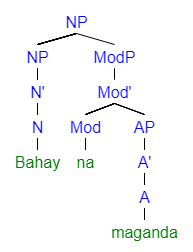 (1a) Simplified syntax tree adapted from Scontras (2014) example 9a, made with http://mshang.ca/syntree/
|
| ||||||||||||||||||||||||||
In (2a), the linker -ng connected the adjective ‘maganda’ (beautiful) and the noun ‘bahay’ (house) to create the grammatical phrase ‘magandang bahay’ ('beautiful house'). In the previous example, the noun came before the adjective. In this example, the adjective came before the noun. Despite the order being different, the meaning is the same. The linker -ng is still needed to show that there is modification, that 'maganda' (beautiful) is modifying 'bahay' (house). The linker -ng is used in this example because the word before the linker, 'maganda' ends with a vowel. Without the linker -ng, the phrase is ungrammatical as shown in (2b). In (2b), there is no modification because the linker is missing. It is just like listing the words 'house' and 'beautiful'. The symbol * represents the missing modifier and the ungrammatical phrase. The following tree shows the grammatical phrase in (2a). The tree is very similar to the tree in (1a) except that this time, NP 'bahay' is the complement and AP 'maganda' is in the specifier position of NP.
|
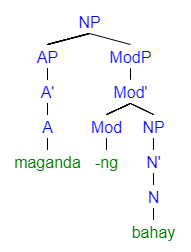 (2a) Simplified syntax tree adapted from Scontras (2014) example 9a', made with http://mshang.ca/syntree/
|
| ||||||||||||||||||||||||||
However, if the adjective appears in predicative position, linker is prohibited. It is when the property of being 'beautiful' is ascribed to the 'house' using a verb. In other words, when an adjective is a predicate. If you add a linker, it results into an ungrammatical sentence as shown in (3b). When the verb is assigning the adjective to the noun, a linker should not be placed. The symbol (!) represents the error when a linker is incorrectly placed. The tree shows the grammatical phrase in (3a). AP 'maganda' is assigned to 'bahay' by the verb 'ang' and ModP is not included.
|
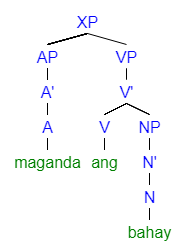 (3a) Simplified syntax tree adapted from Scontras (2014) example 9b, made with http://mshang.ca/syntree/
|
| |||||||||||||||||||||||||||||
→ In the examples, adjectives were used to show the distribution of linker. The distribution of the linker is similar in adverbs and modifier nouns. We can easily replace the adjective in the examples with an adverb and the noun with a verb to turn it into a context of adverbial modification. The examples can be replaced with the adverbial phrases 'tumakbong mabilis' or 'mabilis na tumakbo' which both means ('ran quickly'). If the adjective and the noun are replaced with two nouns, it will turn into nominal modification. The examples can be replaced with phrases that have nominal modifiers like 'babaeng doktor' ('woman, who is a doctor') and 'doktor na babae' ('woman-doctor'). The same linkers (na and -ng) are used and they pattern the same way in adverbial and nominal modification: linkers are obligatory in attributive position but are prohibited in predicate position.
Clausal Modifier
Linker is also obligatory when a clause is modifying a word. In (1a), the linker -ng is needed for the clause 'binili ni Maria' to modify 'libro'. The linker -ng is used because 'libro' ends with a vowel. Similar to the other types of modifiers, a linker is needed to say that the clause is modifying the noun. There is no modification if the linker is not present. The only difference here is that the word doing the modifying is a series of words, a clause instead of a single word. If the linker -ng is not included, the phrase is ungrammatical as shown in (1b). In (1b), the phrase cannot mean 'the book that Maria bought' because there is no element that produces modification. The asterisk (*) represents the missing linker and the ungrammatical phrase.The following tree shows ModP (modifier phrase) as an adjunct to DP (determiner phrase) and the clause (TP) as a complement to Mod -ng.
|
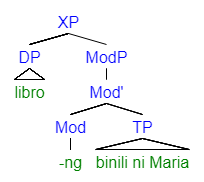 (1a) Simplified syntax tree adapted from Scontras (2014) example 14a, made with http://mshang.ca/syntree/
|
|
| ||||||||||||||||||||||||||||||||||||||
The relative order of the word being modified and the clause is flexible like the other modifiers. Example (2a) shows the clause 'binili ni Maria' before the noun 'libro' as opposed to the previous example where the noun came before the modifying clause. The linker -ng is still used because 'Maria' ends in a vowel as well. The order is different but the meaning of the two phrases is the same. The tree shows the grammatical phrase in (2a), ModP is again an adjunct to a higher XP and now DP 'libro' is the complement of Mod '-ng'. If there is no linker, the phrase is ungrammatical as shown in (2b).
|
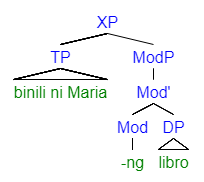 (2a) Simplified syntax tree adapted from Scontras (2014) example 14a', made with http://mshang.ca/syntree/
|
| ||||||||||||||||||||||||||||||||||||||
For adjectival, adverbial, nominal modifiers, linkers are prohibited in predicate position. For clausal modifiers, linkers are prohibited in matrix clauses. In a matrix clause, adding a linker results in an ungrammatical sentence as shown in (3b). The property of 'being seen' is ascribed to the noun 'house' using a verb. The sentence in (3a) is grammatical because the linker is not included in the sentence. The following tree shows the grammatical sentence without ModP. The example (3b) would be grammatical if -ng was not placed there. The symbol ( ! ) represents the error when a linker is incorrectly placed.
|
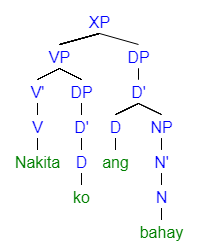 (3a) Simplified syntax tree adapted from Scontras (2014) example 13a, made with http://mshang.ca/syntree/
|
| |||||||||||||||||||||||||||||||||||
Summary of the distribution of linker:
The following table [10] summarizes the distribution of linker that has been discussed in this section.
| Required | Prohibited |
|---|---|
| Attributive Adjective | Predicative Adjective |
| Adverbial modifier | Predicative Adverbial |
| Nominal Modifier | Predicative Nominal |
| Relative Clause | Matrix Clause |
Adjectives
According to Sabbagh,[11] Tagalog has two major types of adjectives. The passive adjectives and the ma- adjectives. Adjectival passives generally form a larger paradigm with transitive verbs. For example, the adjective 'basag' (‘broken’) is related to the transitive verb 'nagbasag' (‘to break’). In contrast, ma- adjectives are related to intransitive verbs.The ma- adjective 'ma- tahimik' is related to the intransitive verb 'tumahimik' (‘to become quiet’). Adjectival passives and ma- adjectives also have distinct morphological and phonological characteristics. Firstly, ma- adjectives are prefixed with ma- while passive adjectives are always unaffixed. Next, the stress on ma- adjectives are either penultimate (second to the last syllable) or ultimate (last syllable) while the stress on passive adjectives are always ultimate. The symbol (´) represents the stress in the words in the following examples.
Examples of passive adjectives:[12] 'baság' (‘broken’), 'punít' (‘ripped’), 'sunóg' (‘burnt’), 'batí' (‘beaten’), 'gamít' (‘used’), 'tapós' (‘finished’), 'abalá' (‘busy /occupied'), 'kilalá' (‘well-known’), 'hiló' (‘dizzy’)
Examples of ma- adjectives:[13] 'ma-mahal' (‘expensive’), 'ma-saráp' (‘delicious’), 'ma-dali' (‘quick’), 'ma-ínit' (‘hot’), 'ma-ganda' (‘beautiful’), 'ma-tahimik' (‘quiet’), 'ma-búti' (‘good’), 'ma-talino' (‘intelligent’)
Other affixes denote different meanings. For example, pinaká- is the superlative word 'the most'. To say a person is the strongest is to say 'pinaka- malakás' (strongest).
Sequence of modifiers in a noun phrase
The following tables show a possible word order of a noun phrase containing a modifier.[14] Since word order is flexible in Tagalog, there are other possible ways in which one could say these phrases.To read more on Tagalog word order, head to the Word Order section.
| Marker | Possessive | Quantity | Verbal Phrase | Adjectives | Noun | Head Noun | |
|---|---|---|---|---|---|---|---|
| Example | ang | kaniyang | apat na | piniritong | mahabang | Vigang | lumpia |
| Gloss | the | her | four | fried | long | Vigan | spring roll |
| Translation | her four fried, long Vigan spring rolls | ||||||
| Example | iyang | inyong | limang kahong | binasag ng batang | puting | Insik na | pinggan |
| Gloss | those | your | five boxes | that the children broke | white | Chinese | plates |
| Translation | those five boxes of yours of white Chinese plates that the children broke | ||||||
Enclitic particles
Tagalog has enclitic particles that have important information conveying different nuances in meaning. Below is a list of Tagalog's enclitic particles.
- na and pa
- na: now, already
- pa: still, else, in addition, yet
- man, kahit: even, even if, even though
- bagamán: although
- ni (plural: niná): marks personal names that are not the focus of the sentence; indicates possession.
- si (plural: siná): marks and introduces personal names
- ngâ: indeed; used to affirm or to emphasise. Also softens imperatives.
- din (after a vowel: rin): too, also
- lamang (contracted as lang): limiting particle; only or just
- daw (after a vowel: raw): a reporting particle that indicates the preceding information as secondhand; they say, he said, reportedly, supposedly, etc.
- pô (less respectful form: hô): marker indicating politeness.
- ba: used to end yes-and-no questions and optionally in other types of questions, similar to Japanese -ka and Chinese mā (嗎), but not entirely.
- muna: for now, for a minute and yet (when answering in the negative).
- namán: used in making contrasts; softens requests; emphasis
- kasí: expresses cause; because
- kayâ: expresses wonder; I wonder; perhaps (we should do something); also optionally used in yes-and-no questions and other forms of questions
- palá: expresses that the speaker has realized or suddenly remembered something; realization particle; apparently
- yatà: expresses uncertainty; probably, perhaps, seems
- tulóy: used in cause and effect; as a result
- sana: expresses hope, unrealized condition (with verb in completed aspect), used in conditional sentences.
The order listed above is the order in which the particles follow if they are used in conjunction with each other. A more concise list of the orders of monosyllabic particles from Rubino (2002) is given below.[15]
- na / pa
- ngâ
- din ~ rin
- daw ~ raw
- pô / hô
- ba
The particles na and pa cannot be used in conjunction with each other as well as pô and hô.
- Dumatíng na raw palá ang lola mo.
- "Oh yes, your grandmother has apparently arrived."
- Dumatíng na raw palá ang lola mo.
- Palitán mo na rin.
- "Do change it as well."
- Palitán mo na rin.
Note for "daw/raw and rin/din": If preceding letter is a consonant except y and w, the letter d is used in any word, vice versa for r e.g., pagdárasal, instead of pagdádasal
Although in everyday speech, this rule is often ignored.
- Walâ pa yatang asawa ang kapatíd niyá.
- "Perhaps his brother still hasn’t a wife."
- Walâ pa yatang asawa ang kapatíd niyá.
- Itó lang kayâ ang ibibigáy nilá sa amin?
- "I wonder, is the only thing that they'll be giving us?"
- Itó lang kayâ ang ibibigáy nilá sa amin?
- Nag-aral ka na ba ng wikang Kastilà?
- "Have you already studied the Spanish language?"
- Nag-aral ka na ba ng wikang Kastilà?
- Batà pa kasí.
- "He's still young, is why."
- Batà pa kasí.
- Pakisulat mo ngâ muna ang iyóng pangalan dito.
- "Please, do write your name here first."
- Pakisulat mo ngâ muna ang iyóng pangalan dito.
The words daw and raw, which mean “he said”/“she said”/“they said”, are sometimes joined to the real translations of “he said”/”she said”, which is sabi niyá, and “they said”, which is sabi nilá. They are also joined to the Tagalog of “you said”, which is sabi mo. But this time, both daw and raw mean “supposedly/reportedly”.
- Sabi raw niyá. / Sabi daw niyá.
- "He/she supposedly said."
- Sabi raw niyá. / Sabi daw niyá.
- Sabi raw nilá. / Sabi daw nilá.
- "They supposedly said."
- Sabi raw nilá. / Sabi daw nilá.
- Sabi mo raw. / Sabi mo daw.
- "You supposedly said."
- Sabi mo raw. / Sabi mo daw.
Although the word kasí is native Tagalog for “because” and not slang, it is still not used in formal writing. The Tagalog word for this is sapagká’t or sapagkát. Thus, the formal form of Batà pa kasí is Sapagká’t batà pa or Sapagkát batà pa. This is sometimes shortened to pagká’t or pagkát, so Sapagká’t batà pa is also written as Pagká’t batà pa or Pagkát batà pa. In both formal and everyday writing and speech, dahil sa (the oblique form of kasí; thus, its exact translation is “because of”) is also synonymous to sapagká’t (sapagkát), so the substitute of Sapagká’t batà pa for Batà pa kasí is Dahil sa batà pa. Most of the time in speech and writing (mostly everyday and sometimes formal), dahil sa as the Tagalog of “because” is reduced to dahil, so Dahil sa batà pa is spoken simply as Dahil batà pa.
Word order
Tagalog has a flexible word order compared to English. While the verb always remains in initial position, the order of noun phrase complements that follow is flexible. An example provided by Schacter and Otanes can be seen in (1).
| (1)
(Kroeger, 1991: 136 (2)) |
Tagalog: | Nagbigay | ng=libro | sa=babae | ang=lalaki |
|---|---|---|---|---|---|
| Gloss: | gave | GEN=book | DAT=woman | NOM=man | |
| English: The man gave the woman a book. | |||||
The flexibility of Tagalog word order can be seen in (2). There are six different ways of saying 'The man gave the woman a book.' in Tagalog. The following five sentences, along with the sentence from (1), include the same grammatical components and are all grammatical and identical in meaning but have different orders.
| (2)
(Kroeger, 1991: 136 (2)) |
Tagalog: | Nagbigay | ng=libro | ang=lalaki | sa=babae |
|---|---|---|---|---|---|
| Gloss: | gave | GEN=book | NOM=man | DAT=woman | |
| Tagalog: | Nagbigay | sa=babae | ng=libro | ang=lalaki | |
| Gloss: | gave | DAT=woman | GEN=book | NOM=man | |
| Tagalog: | Nagbigay | sa=babae | ang=lalaki | ng=libro | |
| Gloss: | gave | DAT=woman | NOM=man | GEN=book | |
| Tagalog: | Nagbigay | ang=lalaki | sa=babae | ng=libro | |
| Gloss: | gave | NOM=man | DAT=woman | GEN=book | |
| Tagalog: | Nagbigay | ang=lalaki | ng=libro | sa=babae | |
| Gloss: | gave | NOM=man | GEN=book | DAT=woman |
The principles in (3) help to determine the ordering of possible noun phrase complements.[16] In a basic clause where the patient takes the nominative case, principles (i) and (ii) requires the actor the precede the patient. In example (4a), the patient, 'liham' (letter) takes the nominative case and satisfies principles (i) and (ii). The example in (4b) shows that the opposite ordering of the agent and patient does not result in an ungrammatical sentence but rather an unnatural one in Tagalog.
|
| ||||||||||||||||||||||||||||||
In example (5), the verb, 'binihag', (captivated) is marked for active voice and results in the actor ('Kuya Louis') to take the nominative case. Example (5) doesn't satisfy principles (i) and (ii). That is, principle (i) requires the Actor ('Kuya Louis') to precede all other arguments. However, since the Actor also takes the nominative case, principle (ii) requires the phrase 'Kuya Louis' to come last. The preferred order of agent and patient in Tagalog active clauses is still being debated. Therefore, we can assume that there are two "unmarked" word orders: VSO or VOS.
| (5)
(Kroeger, 1991: 137 (5)) |
Tagalog: | Binihag | si=Kuya Luis | ng=kagandahan | ni=Emma |
|---|---|---|---|---|---|
| Gloss: | PERF-capture-OV | NOM=big brother Luis | GEN=beauty | GEN=Emma | |
| English: Big brother Luis was captivated by Emma's beauty. | |||||
A change in word order and trigger generally corresponds to a change in definiteness ("the" vs "a") in English. Example (6) shows a change in word order, triggered by the indirect, "ng." Example (7) shows a change in word order, triggered by the direct, "ang."
|
| ||||||||||||||||||||||||||||||||||||||
Word order may be inverted (referred to in Tagalog grammar as Kabalikang Anyo) by way of the inversion marker 'ay ' ( ’y after vowels in informal speech, not usually used in writing). Contrary to popular belief, this is not the copula 'to be' as 'ay' does not behave as an existential marker in an SVO structure and an inverted form VSO does not require 'ay' since the existentiality is denoted by case marking. A slight, but optional, pause in speech or a comma in writing may replace the inversion marker. This construction is often viewed by native speakers as formal or literary.
In this construction (ay-inverson), the 'ay' appears between the fronted constituent and the remainder of the clause. The fronted constituent in the construction includes locations and adverbs. Example (8)- (11) shows the inverted form of the sentences in previous examples above.
| (8) | Tagalog: | Ang | bata | ay | kumanta | |
|---|---|---|---|---|---|---|
| Gloss: | Direct | child | AY | sing | ||
| English: The child is singing. | ||||||
| (9) | Tagalog: | Ang | serbesa | 'y | ininom | nila |
| Gloss: | Direct | beer | AY | drink | them | |
| English: They are drinking the beer. | ||||||
| (10) | Tagalog: | Ang | mga=dalaga | 'y | magaganda. | |
| Gloss: | Direct | PL=girls | AY | beautiful | ||
| English: The girls are beautiful. | ||||||
| (11) | Tagalog: | Ang | ulan | ay | malakas | |
| Gloss: | Direct | rain | AY | strong | ||
| English: The rain is strong. | ||||||
In (8), and (11), the fronted constituent is the subject. On the other hand, in (9), the fronted constituent is the object. Another example of a fronted constituent in Tagalog is, wh-phrases. Wh-phrases include interrogative questions that begin with: who, what, where, when, why and how. In Tagalog, wh-phrases occur to the left of the clause. For example, in the sentence, 'Who are you?', which translates to, 'Sino ka?' occurs to the left of the clause. The syntactic tree of this sentence is found in (12a). As we can see in (12a), the complementizer position is null. However, in the case where an overt complementizer is present, Sabbagh (2014) proposes that the wh-phrase lowers from Spec, CP and adjoins to TP when C is overt (12b). The operation in (12b) is known as, WhP lowering.
 (12a) Syntax tree, made with http://mshang.ca/syntree/
|
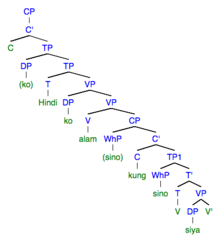 (12a), Syntax tree adapted from Sabbagh (2014), example 62, made with http://mshang.ca/syntree/
|
This operation of lowering can also be applied in sentences to account for the verb-initial word order in Tagalog. The subject-lowering analysis states that, "the subject lowers from Spec, TP and adjoins to a projection dominated by TP.".[17] If we use the example from (2), Nagbigay ang lalaki ng libro sa babae. and applied subject lowering, we would see the syntax tree in (13a).If we lowered the subject, ang lalaki, to an intermediate position within VP, we would be able to achieve a VOS word order and still satisfy subject lowering.[17] This can be seen in (13b).
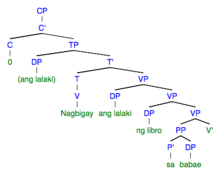 (13a) Syntax tree, adapted from Sabbagh (2014), 70 (55), made with http://mshang.ca/syntree/
|
 (13a) Syntax tree, adapted from Sabbagh (2014), 70 (55), made with http://mshang.ca/syntree/
|
Lowering is motivated by a prosodic constraint called, WeakStart.[18] This constraint is largely based on the phonological hierarchy. This constraint requires phonological the first element within a phonological domain to be lower on the prosodic hierarchy than elements that follow it, within the same domain.[19]
Negation
There are three negation words: hindî, walâ, and huwág.
Hindî negates verbs and equations. It is sometimes contracted to ‘dî.
- Hindî akó magtatrabaho bukas.
- "I will not work tomorrow."
- Hindî mayaman ang babae.
- "The woman is not rich."
Walâ is the opposite of may and mayroón ("there is").
- Walâ akóng pera.
- Akó ay walang pera.
- "I do not have money."
- Waláng libró sa loób ng bahay niyá.
- "There are no books in his house."
Huwág is used in expressing negative commands. It can be used for the infinitive and the future aspect. It is contracted as ‘wag.
- Huwág kang umiyák.
- "Do not cry."
- Huwág kayóng tatakbó rito.
- "Do not run here."
There are two (or more) special negative forms for common verbs:
- Gustó/Ibig/Nais ko nang kumain.
- "I would like to eat now." (Positive)
- Ayaw ko pang kumain.
- "I don't want to eat yet." (Negative)
Conjunctions
Tagalog uses numerous conjunctions, and may belong to one of these possible functions:
- separate non-contrasting ideas (e.g. at "and")
- separate contrasting ideas (e.g. ngunit "but")
- give explanations (e.g. kung "if")
- provide circumstances (e.g. kapag "when")
- indicate similarities (e.g. kung saan "where")
- provide reasons (e.g dahil "because")
- indicate endings (e.g. upang "[in order] to")
Interrogative words
Tagalog's interrogative words are: alín, anó, bákit, gaáno, ilán, kailán, kaníno, kumustá, magkáno, nakaníno, nasaán, níno, paáno, saán, and síno. With the exceptions of bakit, kamustá, and nasaán, all of the interrogative words have optional plural forms which are formed by reduplication. They are used when the person who is asking the question anticipates a plural answer and can be called wh-phrases. The syntactic position of these types of phrases can be seen in (12a).
|
|
| |||||||||||||||||||||||||||||||||||||||||||||||||||
|
| |||||||||||||||||||||||
Gaano (from ka- + anó) means how but is used in inquiring about the quality of an adjective or an adverb. The rootword of the modifier is prefixed with ka- in this construction (16a).Ilán means how many (16b). Kumustá is used to inquire how something is (are).(16c) It is frequently used as a greeting meaning How are you? It is derived from the Spanish ¿cómo está?. Magkano (from mag- + gaano) means how much and is usually used in inquiring the price of something (16d). Paano (from pa- + anó) is used in asking how something is done or happened (16e).
|
|
| |||||||||||||||||||||||||||||||||||||||||||||
|
| |||||||||||||||||||||||||||||
Nino (from ni + anó) means who, whose, and whom (18a). It is the indirect and genitive form of sino. Sino (from si + anó) means who and whom and it is in the direct form (18b). Kanino (from kay + anó) means whom or whose (18c). It is the oblique form of sino (who).
|
|
| ||||||||||||||||||||||||||||||
See also
Notes
- ↑ http://learningtagalog.com/grammar/verbs/aspects/overview.html
- ↑ http://www.seasite.niu.edu/tagalog/grammar%20activities/Grammar%202/Verbal%20Aspect/Verbalaspect-fs.htm
- ↑ http://www.seasite.niu.edu/tagalog/tagalog_verbs.htm
- ↑ Tagalog voice does not correspond well to the terms active and passive, nor to active and antipassive in ergative languages. The term focus, as used in ergative languages, is also an inadequate way of describing the Tagalog voice, therefore the distinct term trigger has become common to describe languages with Philippine-type alignment systems.
- 1 2 3 Kata, nita and kanita are not widely used. Kitá was the alternative pronoun for first person dual.
- ↑ This is a contraction of "ko ikaw". Neither "ko ka" or "ka ko" are grammatically acceptable.
- ↑ Scontras & Nicolae (2014), 21
- ↑ Scontras & Nicolae (2014), 25
- ↑ Scontras & Nicolae (2014), 21
- ↑ Scontras & Nicolae (2014), 23
- ↑ Sabbagh (2011), 1427
- ↑ Sabbagh(2011), 1427
- ↑ Sabbagh(2011), 1429
- ↑ Ramos (1971), 126
- ↑ Rubino, Carl Ralph. 2002. Tagalog-English, English-Tagalog dictionary / Taláhuluganang Pilipino-Ingglés, Ingglés-Pilipino Taláhuluganang. Conshohocken, PA: Hippocrene Books.
- ↑ Kroeger (1991), 136 (2)
- 1 2 Sabbagh (2014), 70 (55)
- ↑ Sabbagh (2014), 62 (45)
- ↑ Sabbagh (2014), 59
Bibliography
- Kroeger, P. R. (1991). Phrase structure and grammatical relations in Tagalog
- Ramos, T. (1971). Tagalog Structures. Honolulu, HI: University of Hawaii Press. p. 126.
- Rubino, C. (2002). Tagalog-English, English-Tagalog dictionary / Taláhuluganang Pilipino-Ingglés, Ingglés-Pilipino Taláhuluganang. Conshohocken, PA: Hippocrene Books.
- Sabbagh, J. (2014). Word order and Prosodic‐Structure constraints in Tagalog. Syntax, 17(1), 40-89. doi:10.1111/synt.12012
- Sabbagh, J. (2011). Adjectival passives and the structure of VP in Tagalog. Lingua, 121, 1424-1452. doi: 10.1016/j.lingua.2011.03.006
- Scontras, G. & Nicolae A. (2014). Saturating syntax: Linkers and modification in Tagalog. Lingua, 149, 17-33. doi: 10.1016/j.lingua.2014.05.005
External links
| For a list of words relating to Tagalog grammar, see the Tagalog language category of words in Wiktionary, the free dictionary. |
| Tagalog language edition of Wikipedia, the free encyclopedia |
| Wikibooks has a book on the topic of: Tagalog |
| Tagalog grammar repository of Wikisource, the free library |
| Wikivoyage has a travel guide for Filipino phrasebook. |
- Tagalog grammar Free and comprehensive Tagalog grammar reference
- Interactive Language and Filipino Culture Resources Part of the SEAsite Project at Northern Illinois University, DeKalb, Illinois, USA